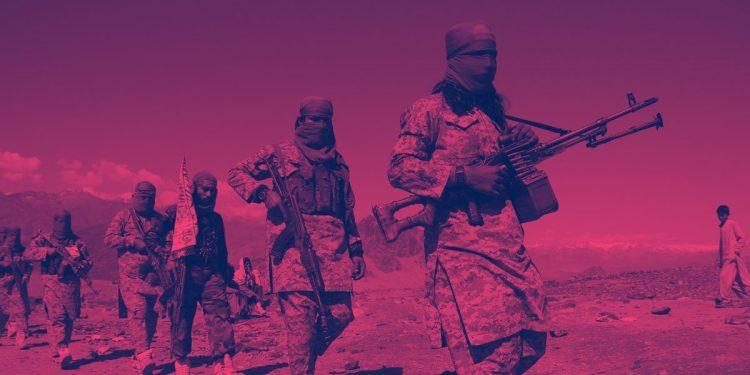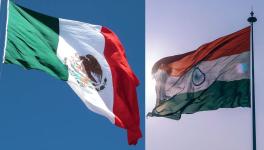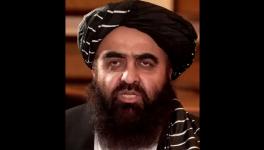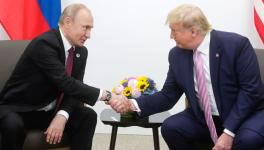Taliban’s Next Big Challenge a Hydra-Headed Monster

Defeated, humiliated and forced to surrender to the Taliban, the United States ignominiously exited Afghanistan on August 31, 11 days before the 20th anniversary of 9/11.
The Taliban, led by Mullah Haibatullah Akhunzada, is back with a bang after a blitzkrieg in a precipitous twist of fate with the ouster of the same so-called superpower that intended to oust it 20 years ago for harbouring the architect of the September 11 attacks, Osama bin Laden.
Now, the Taliban faces the bigger challenge of reigning in the other terrorist organisations, especially its rivals, spread in the 34 provinces of Afghanistan. The momentary jubilation of the Taliban at the surrender of the US and the re-establishment of its emirate—celebrated by other global terror outfits, like al-Qaeda and its affiliate Al-Qaeda in the Arabian Peninsula, on chat forums—could soon give away to a bloodier war for supremacy and control.
The Taliban faces the hydra-headed monster of al-Qaeda, its offshoot Al Qaeda in the Indian Subcontinent (AQIS), Haqqani Network, Islamic State of Khorasan Province (ISKP) and Tehrik-e-Taliban Pakistan (TTP).
KABUL BLAST AND ‘CRACKS’ IN TALIBAN-HAQQANI TIES
The bomb blast at the Kabul airport on August 26, which killed 28 Talibs, 13 US troops and scores of civilians, was the curtain-raiser to the gory spectacle that is likely to unfold once the Taliban’s rival terror groups, especially the ISKP, which triggered the explosion, fight a pitched battle for dominance.
The Doha pact—signed between US special representative for Afghanistan reconciliation Zalmay Khalilzad and Taliban cofounder Mullah Abdul Ghani Baradar—mentions that the group “will not allow any of its members, other individuals or groups, including al-Qaida, to use the soil of Afghanistan to threaten the security of the United States and its allies”.
The Taliban will prevent such groups/individuals from recruiting, training and fundraising. It will not issue visas, passports, travel permits or other legal documents to them and not cooperate with/host them, according to the pact.
The blast has made the Doha pact futile and meaningless considering that the terror groups are beyond the Taliban’s control. Taliban spokesman Zabihullah Mujahid’s promise of not allowing anyone to use Afghanistan to launch attacks on other countries sounds hollow.
To prevent terror groups from attacking the US and its allies and neighbours, like, Pakistan and India, the Taliban first needs to rein them in, an insurmountable task given its history of affiliations with other outfits and the changing allegiances of its members.
The most shocking development is the reported rift over power-sharing between the Taliban and its most trusted ally, the Sirajuddin Haqqani-led Haqqani Network. This has delayed government formation. Baradar has been reportedly injured in a gunfight between the Taliban and Haqqanis, who are responsible for the security of Kabul under Sirajuddin’s brother and the network’s second-in-command Anis Haqqani.
On September 5, a suicide bomber of the TTP, which has renewed its allegiance to the Taliban, detonated his explosives at a checkpoint on the Quetta-Mastung Road, 25 km south of Pakistan’s Balochistan capital Quetta, killing, at least, three Frontier Corps personnel and wounding 15. The blast shows how the Taliban victory will prod other terrorist groups to launch attacks on Afghanistan’s neighbours.
Disgruntlement in Taliban ranks could lead to its extreme radical members joining other terror groups. Hafiz Saeed Khan, the co-founder and first chief of ISKP and his deputy Mullah Abdul Rauf Khadim, who were both killed by US forces in Afghanistan in 2015-16, were disgruntled Taliban members. Abdul Rauf Aliza, who played a key role in the formation of ISKP, too was a former Taliban member held at Guantanamo Bay and killed in a US drone strike in 2015.
The 12th report of the Analytical Support and Sanctions Monitoring Team of the United Nations Security Council (UNSC) in June said that several al-Qaeda members and foreign terrorists aligned to the Taliban are present in many provinces. Besides this, Afghanistan’s vast rugged and mountainous terrain, complex ethnicity and history of conflicts with the dominance of warlords are other hurdles in controlling the rival outfits.
AL-QAEDA
The Ayman al-Zawahiri-led al-Qaeda is present in, at least, 12-15 provinces, including Ghazni, Helmand, Khost, Kunar, Kunduz and Nimruz. According to the UNSC, the Taliban is sheltering most senior al-Qaeda commanders, including al-Zawahiri, privately while it publicly “barred its members” in February “from sheltering foreign fighters”.
With around 500 members present in Afghanistan, according to the UNSC report, the al-Qaida has no intention of breaking its ties with the Taliban, which have grown “deeper as a consequence of personal bonds of marriage and shared partnership in struggle, now, cemented through second generational ties”.
The latest proof of the deepening ties is the return of Dr Amin al-Haq, who headed the Black Guard, the elite unit responsible for bin Laden’s security that helped him escape to Pakistan during the Battle of Tora Bora in 2011.
In the last 20 years, the al-Qaeda, which also has close ties with the TTP, pledged its allegiance to Akhunzada several times and held a series of meetings with the Taliban in 2019-20. In 2019, Gul Agha Ishakzai, the former adviser to Taliban’s late co-founder and its first chief, Mullah Mohammad Omar, and other senior leaders met bin Laden’s late son Hamza and assured him of an everlasting relationship.
Mujahid’s earlier statement that “nowhere in the [Doha] agreement has it been mentioned that we have or don’t have ties with anyone” and “what has been agreed upon is that no threat should be posed from Afghan soil to the US and its allies”, shows the Taliban’s eagerness to continue the ties with al-Qaeda.
The fact that the US security apparatus acknowledges the presence of al-Qaeda in Afghanistan was evident when Pentagon press secretary John Kirby indirectly contradicted President Joe Biden’s false claim in August that the group is “gone” from Afghanistan by telling the media: “We know that al-Qaeda is a presence as well as ISIS in Afghanistan.”
Chairman of the US Joint Chiefs of Staff General Mark Milley’s ominous prediction that the al-Qaeda could regroup in Afghanistan in less than two years could prove to be right with the Taliban freeing hundreds of its operatives as the Afghan provinces fell like dominos.
Al Qaeda in the Indian Subcontinent
With 400-600 members led by Osama Mahmood, the Pakistan-based AQIS operates mainly in Nimruz, Helmand and Kandahar. Zawahiri created the group in September 2014 primarily to bolster the parent organisation’s presence in the region by cementing ties with local terror groups.
The AQIS, whose fighters are embedded in the Taliban, was formed primarily to attack the US and NATO forces in Afghanistan, establish Sharia law across South Asia, revive the caliphate in the Indian subcontinent and attack military targets in Afghanistan, Pakistan, India, Myanmar and Bangladesh.
The AQIS “is reported to be such an organic, or essential, part of the insurgency that it would be difficult, if not impossible, to separate it from its Taliban allies”, the UNSC’s June report said.
The strategic-personal ties between the Taliban and the AQIS were further revealed in September 2019, when a joint US-Afghan raid in Helmand eliminated the then-AQIS chief Asim Umar, an Indian national being sheltered by the Taliban. Seeking protection and training, the AQIS has maintained ties to the Taliban, according to the US State Department.
Islamic State of Khorasan Province
Spread in north-eastern Afghanistan, especially Nuristan and Kunar, the ISKP has around 2,200 members led by Shahab al-Mujahir. It is the most ruthless terror group, like its parent organisation Islamic State (IS), in Afghanistan and also the Taliban’s arch-enemy.
The ISKP—which aims to establish a caliphate in South and Central Asia and enjoys the support of radical Salafists and some local ethnic Tajiks and Uzbeks in several provinces—was formed in 2015 by disgruntled Taliban members and breakaway TTP members who swore allegiance to late IS chief Abu Bakr al-Baghdadi.
The Kabul airport explosion eclipsed ISKP’s previous attacks in brutality and toll—its suicide bombers killed 85 people outside a high school in Kabul in May, around 22 at Kabul University in November 2020 and 128 people at an election rally in Mastung, Pakistan, in July 2018.
Between 2016 and 19, the group’s strength was significantly reduced by the US-Afghan joint operations and Taliban raids. As a result, it was driven out of its stronghold of Nangarhar. Subsequently, the ISKP established sleeper cells in Kabul and a few other provinces. The ISKP’s strength, however, could be reinforced by thousands of prisoners who escaped when the prisons, including at Bagram, were overrun recently.
The ISKP, which loathes the Taliban and differs in ideology and objectives, poses the biggest challenge. Vehemently opposed to any Taliban-US cooperation, the group wants to establish a caliphate “ruled by god” in the region, not a political emirate. Its objectives are much larger and go beyond Afghanistan and Pakistan. In a series of videos in 2015, the ISKP said: “Know that the Islamic caliphate is not limited to a particular country. These young men will fight against every disbeliever—whether in the west, east, south or north.”
The group has an extreme sectarian and violent ideology. It executes its attacks, especially against Shias and Sikhs, with brutality. The ISKP and the Taliban clashed 207 times, mostly in Nangarhar, Jowzjan and Kunar, between 2017 and 2018, according to the Armed Conflict Location & Event Data Project.
Another danger is of the more radical members of Taliban 2.0 defecting to the ISKP with the emirate trying to present a moderate and accommodating face to the world by promising freedom to women and amnesty to Afghans who collaborated with the US, and assuring representation of minority communities in the government.
Haqqani Network
With strong links to Pakistan’s Inter-Services Intelligence (ISI), the al-Qaeda, the TTP and the Lashkar-e-Taiba, the Haqqani Network was founded by the late Mujahideen fighter Jalaluddin Haqqani in the 1980s.
Nurtured by the Central Intelligence Agency and the ISI to counter the Soviet occupation, the group is now led by Haqqani’s son Sirajuddin. Present in Paktia, Paktika, Khost and Logar provinces, the group’s 3,000-plus fighters are ideologically aligned with the Taliban and considered its most trusted ally.
The Taliban is heavily dependent on the Haqqanis, who played a prominent role in the recapture of Kabul and were notorious for some of the bloodiest attacks on the International Security Assistance Force and the NATO-led Resolute Support Mission in Afghanistan.
However, according to reports, cracks have already appeared in their decades-old relationship with government formation delayed over the Taliban’s insistence on sharing power with representatives of the minority communities while the Haqqani Network calls for an exclusive government. ISI chief Lieutenant General Faiz Hameed rushed to Kabul to reportedly cement these cracks.
In fact, the unverified Twitter handle of Panjshir Observer, which describes itself as an independent news outlet, posted that the Taliban and the Haqqanis had a gunfight over tactics to defeat the Northern Resistance Front of Afghanistan, led by Ahmad Massoud, the son of late Mujahideen fighter Ahmad Shah Massoud, in Panjshir.
What makes the situation trickier and more dangerous is the strong links between the Haqqanis and the al-Qaeda. According to the UNSC, the Haqqanis are the “primary liaison” between the Taliban and the al-Qaeda. “Contacts between al-Qaeda and the Haqqani Network remain particularly close. They share long-standing personal relationships, intermarriage, a shared history of struggle and sympathetic ideologies.”
Tehrik-e-Taliban Pakistan
The TTP members officially announced the formation of the group in 2007 under the leadership of Baitullah Mehsud to overthrow the Pakistani government.
Mehsud and two of his successors, Hakimullah Mehsud and Maulana Fazlullah, were killed in US drone strikes in 2009, 2013 and 2018 respectively after which Noor Wali Mehsud assumed the command. With 2,500-6,000 fighters, the TTP is present in Nangarhar, and had assisted the Taliban in fighting the US and NATO in Afghanistan despite differences. Thousands of prisoners released by the Taliban included former TTP deputy chief Maulvi Faqir Mohammad.
Three weeks before the fall of Kabul, Husain Haqqani, Pakistan’s former ambassador to the US, had warned that “the Taliban’s victory will have an equally disastrous effect on Pakistan’s domestic peace and security”. In a column in the Foreign Affairs magazine on July 22, he wrote: “The ascendance of Afghan Islamists next door will only embolden radicals at home. Efforts to force the Taliban’s hand might result in violent blowback with Pakistani Taliban attacking targets inside Pakistan.”
Afghanistan could soon become a terror hotspot—like when after the Mujahideens defeated the Soviets with US and Pakistan’s assistance—with different groups harbouring ambitions of expanding their areas of operations and the scale of their attacks.
The TTP—which has sworn its allegiance to the Taliban—and the ISKP could reconstitute and launch deadlier attacks. The ISKP had renamed its magazine from Nawai Afghan Jihad to Nawai Ghazwat-ul-Hind early this year much before the US withdrawal, making it clear that its next target is India.
Get the latest reports & analysis with people's perspective on Protests, movements & deep analytical videos, discussions of the current affairs in your Telegram app. Subscribe to NewsClick's Telegram channel & get Real-Time updates on stories, as they get published on our website.
























